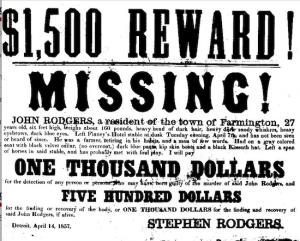By Gregory Stejskal
There is an apocryphal story – Ernest Hemingway was having lunch with some writer friends when he proposed a wager. He bet $10 that he could write a story in six words. With no doubt some curiosity, everyone at the table put $10 in the pot. Hemingway wrote on a napkin, “For sale: baby shoes, never worn.” Hemingway passed the napkin around the table and collected his winnings.
Hemingway’s six word story is an extreme example of what is called flash fiction. My experience with something that might qualify as flash fiction was an 1857 reward poster that my wife found at an estate sale in Ann Arbor (Michigan).
The poster had a place, Detroit, and a date of April 14, 1857, and was offering “$1,500 Reward!” for information regarding a missing man, “John Rodgers, a resident of the town of Farmington, age 27.” The poster provides a physical description of John Rodgers and the clothing he was wearing when last seen leaving “Finney’s Hotel stable at dusk Tuesday evening, April 7th” (1857) where he left a span (pair) of horses.
The poster also indicates a suspicion of “foul play” and offers $1,000 “for the detection of any person or persons who may have been guilty of the murder of John Rodgers….” The reward is offered by Stephen Rodgers.
Like Hemingway’s baby shoes, the poster doesn’t so much tell a story as it suggests one.
My wife had the poster framed, and it has hung next to my desk. I have often wondered about the fate of John Rodgers, and what clues were contained on the poster.
The thing that literally stands out is the reward amount, “$1,500” In 1857 $1,500 was a very large amount of money worth about $42,000 today. It isn’t clear who Stephen Rodgers was from the poster, but he must have been a man of some means.
Since having the poster, I have made sporadic inquiries of local historians and checked records trying to find the rest of the story behind the poster.
Lee Peel, a historian of Farmington (Michigan), was able to determine that Stephen and John Rodgers were prosperous farmers with land in Farmington, but he wasn’t able to find any information regarding the incident described in the poster.
Later I happened on an article in the Detroit Free Press about the abolition movement and the rise of the Republican Party in Michigan. In the article Seymour Finney was mentioned. In the 1850s Finney was an abolitionist who ran a hotel in Detroit. Behind the hotel he had a large barn on the northeast corner of State and Griswald Sts. (Today there is an historical marker there.) Finney used the barn to hide runaway slaves until they could cross the Detroit River into Canada. The barn was located just blocks from the river.
Canada was a haven for the erstwhile slaves because in 1837 England had abolished slavery in their entire empire. So any slave that made it to Canada was free.
In the 1840s and 50s, an Underground Railroad developed in the US. Slaves followed established routes to northern states where they were relatively safe. Some of those routes led from the south to Michigan where there were many sympathetic people willing to hide them and aid their passage to Canada.
In fact the Republican Party, which was established by people opposed to the expansion of slavery beyond the states where it existed, began to flourish in Michigan. The party’s first statewide convention was held in Jackson, Michigan in 1854. One the party’s founders was Dr. Nathan Thomas, who had a medical practice in Kalamazoo and maintained a “station” on the Underground Railroad in Kalamazoo.
There were also free Blacks in Michigan who were active in the Underground Railroad. George de Baptiste, a freeman, owned a barbershop and a bakery in Detroit. He also owned a steamship named, T. Whitney, which transported freight and passengers from Detroit to Windsor, Canada. The T. Whitney also surreptiously smuggled escaped slaves to Canada at de Baptiste’s direction.
De Baptiste had formed a secret organization, African-American Mysteries or Order of the Men of Oppression, that worked with the Underground Railroad. Seymour Finney as a “conductor” on the Underground Railroad would have been a member or an affiliate of the secret organization.
Secrecy was necessary because in 1850 the Fugitive Slave Act was enacted by Congress. The act required that slaves apprehended anywhere in the US including “free” states be returned to their slave masters. Rewards were offered for slaves, and despite there being many people in Michigan who were anti-slavery, there were many who were not opposed to slavery or were out to collect a reward. On occasion slave-catchers stayed in Finney’s Hotel while slaves were hidden in the barn.
So John Rodgers was last seen leaving “Finney’s Hotel stable at dusk….” Had he stumbled across some fugitive slaves? Did he attempt to obstruct their escape or did he try to resist efforts by bounty hunters to apprehend slaves?
Recently I talked to a Detroit historian, Bill Loomis, about the poster. Loomis has access to Detroit newspaper archives. (I had previously had other people with access to newspaper archives search for anything relating to John Rodgers disappearance with no success.) Loomis was able to find one article in the Detroit Free Press, dated May 21, 1857 and titled “Verdict in Rodgers Case.”
The article is not about a trial, but an inquest held in the office of Justice Ensworth, presumably acting as coroner. John Rodgers body had been recovered from the Detroit River, but it is not clear from the article when it was recovered. The reward poster was dated April 14th, seven days after he went missing, and the inquest occurred on May 20th.
One witness at the inquest was the father of the deceased, Stephen Rodgers, who offered the reward. Mr. Rodgers testified that he and John had come to the city with a load of pork which was sold. The father kept the proceeds from the sale except for $6 which he gave to his son, John, at about 1-2 pm. Rodgers said that he thought his son had from $25-100 in his possession and that he had two “porte-monnaies” (wallets) with him, a new one and an old one. No money was found with the body.
When Rodgers paid his son the money, he noticed some men standing on the corner nearby. “There were from four to six men and they were talking with one another. I noticed particularly one of them looking at us. They had the appearance of rather hard cases. I never saw them before neither have I seen them since.”
Also testifying at the inquest was a Dr. Terry who apparently was the medical examiner. He had done an analysis of the deceased’s stomach which had been delivered to him the day before in a jar. (In a time before refrigeration, this evokes some unsavory images.) Dr. Terry determined that John Rodgers last meal was corned beef and potatoes. Due to the state of digestion, Dr. Terry believed Rodgers died 2-3 hours after his last meal.
Dr. Terry testified that he had conducted “chemical tests to the contents of the stomach to ascertain whether opium or any of its preparations were present including morphine or its salts. Nothing of the kind was detected. (This seems to infer that at that time if poisoning were suspected, the drug of choice was an opiate.) The time that has elapsed since the death of Mr. Rodgers would render the detection of a vegetable poison very difficult if not impossible.”
Dr. Terry concluded: “I would say, that in regard to Mr. Rodgers’ death, it strikes me that the theory assumed by the physicians on the post mortem examination, that is, that the deceased was drugged is the most probable one. The absence of opium or morphine in the contents of the stomach at such a length of time after his death is no disproof of this supposition.”
The verdict of the jury was: “The jury upon their oaths present that from the appearance of the body and from all the facts and circumstances disclosed by the testimony, they are of the opinion that said Rodgers came to death in the city of Detroit by unlawful means, used by persons or persons unknown to the jurors who are unable definitely to determine from the testimony before them what means in fact were used by the murderers to effect (sic) their diabolical purpose.”
So the jury concluded that Rodgers was murdered, but they didn’t know how or why or by whom. Like the unused baby shoes several possibilities are suggested. I will continue to search for the rest of the story, but at least now I know John Rodgers fate.






